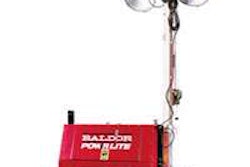 Fighting Back
Fighting Back
By John Latta and Kirk Landers
Contractors and agencies show no signs of surrendering to economic pressures that in turn show little sign of easing their assault.
December 22, 1944. Bastogne, Belgium.
U.S. forces pushing Nazi armies back into Germany are suddenly counterattacked in The Battle of the Bulge.
Massive breakthroughs by German armor pummel American soldiers and the Germans are set to break through to the North Sea. This city is surrounded and the
German commander demands U.S. forces surrender or be “totally annihilated.”
General Tony McAuliffe, commanding the 101st Airborne defenders, sends a one word, morale-boosting, in-your-face
reply: “NUTS.” The city is successfully defended. German armies retreat.
Perhaps it’s an American thing. America’s highway and bridge contractors, it seems, are as disinclined as the 101st Airborne to give up despite similarly lousy odds.
And government agencies are also refusing to give an inch more than necessary, searching for openings and ways to win in the face of a frightening economic onslaught.
Better Roads 2009-2010 Forecast Survey, our exclusive annual sampling of road professionals including the government agencies that operate the road budgets and contractors who specialize in road an bridge work, shows the devastating impact of recession but it also suggests that while the industry may not be surging into recovery, it has stabilized at a low point and is beginning to sense some revival.
The numbers are not good. There is no way to disguise or spin that. But within them are indicators that the fight back has begun.
Two factors that were not influential in recent year surveys have the power to change the 2010 landscape unpredictably: Reauthorization and “stimulus” funding.
Potent wildcards
Reauthorization is in limbo and both government and contracting company planners must make different – conservative, defensive – arrangements without it and the guaranteed flow of predictable funding over a reasonable period of time. Stimulus money for transportation and infrastructure projects has been effective to date according to survey responses and there is more to come – but that funding is likely to come in the same unpredictable way it has to date, making even medium-term planning an adventure. The two factors come together if we consider the impact of the end of stimulus money and the lack of a new surface transportation act to ensure funds keep flowing from Washington.
It is also interesting to see almost half the sample (48 percent) calling ARRA “somewhat effective.” With three percent calling the stimulus programs “very effective” there is a surprisingly strong support level; perhaps it might even be called an endorsement.
Agencies basically felt the recession hit them in the fiscal year before their current one and in this current FY have felt its grip tighten. While state DOT budgets are perhaps more predictably tight, this fiscal year has seen city and country trends virtually as negative as the state trends. What is perhaps most shocking is the degree of loss of this FY over the previous one: 40 percent of the agencies report a decrease in their budget for highway and bridge spending and the average drop is a scary 18 percent.
Consider this: half of all of the surveyed agencies are cutting budgets for road rebuilding, and 60 percent of state agencies are doing so. An even more disturbing trend: more agencies at every level are cutting preventive maintenance budgets than are increasing them.
A quarter of all of the reporting agencies and more than one third of the state DOTS are cutting PM budgets. If one accepts the conventional wisdom that in times of thin road budgets PM becomes the work of choice because you can prevent more miles of bad pavement than you can replace with good pavement, the PM cuts mean agencies are resorting to cutting the last line of defense.
These survey results suggest that, ARRA aside, the nation’s inventory of deficit pavements is about to increase, possibly quite dramatically. This is of course another area where reauthorization could be valuable by allowing more agencies to keep up present PM activity levels.
While city and county forecasts for the next year show respondents expecting more of the same, the real concern is perhaps in state agencies reporting where more than half, 52 percent, expect more budget cuts. With Washington dithering on reauthorization the actual amount of money flowing out into active projects may be frighteningly low.
FROM THE CONTRACTORS



A Holding Pattern
While one percent of contractors expect an ‘excellent” upcoming year and eight percent expect a “very good” year (the same percentages rated 2009 this way) 32 percent foresee a “good” year for their companies, as compared to the 26 percent who rated 2009 this way. But 59 percent expect a below average or bad year. Not technically a wash but static enough to indicate contractors see more of the same. And since, unlike the agencies polled, they also work in other heavy construction markets their outlook almost certainly reflects a gloomy forecast of those areas as well.
A combined 59 percent expect a “fair” (46 percent) or a “poor” (13 percent) year. In looking at 2009 the combined “fair” and poor number was 65 percent. (34 percent and 31 percent respectively) So the climb-out begins slowly. Evidence of a recovery, albeit a painfully slow one, is clearer in the forecasts for contract volume More than one-third of the nation’s contractors expect an increase in contract volume this year, while just 24 percent forecast declines. Historically, that’s how recoveries take hold in heavy construction.
Sure, contractors are expecting more contract volume in 2010. But that can be misleading. Traditionally, as contractors begin to dig out of deep recessions contract volume goes up because they are bidding low just to get the work. Getting acceptable an necessary profit margins comes later in the recovery, how much later of course is a key unanswered question.
Predictably there are few buyers, with agencies or contractors, who are looking to buy equipment, except for trucks. While the overall economic picture is obviously a dominant factor, the lack of a six-year replacement for SAFETEA-LU must also be blamed for deterring some potential buyers.
Also predictable, contractors are doing more “other public works construction” than they have in the recent past and significantly less bridge work. As the recession took hold and big-ticket projects like bridge work became scarcer, contractors have been forced to branch out into other construction niches or drive further.
FROM THE AGENCIES



FROM THE CONTRACTORS

FROM THE AGENCIES

CONTRACTORS: EXECUTIVE SUMMARY
The two major problems facing contractors are intense competition for contracts (80 percent) and declining work opportunities (71 percent).
Contractors expect 2010 to be slightly, ever so slightly, better than last year. Nine percent forecast an above average year and 32 percent expect a good year. Only 9 percent of contractors in our survey rated 2009 as an above average business year and 26 percent rated it as a good year.
Contractors are marginally more optimistic about contract volume for 2010. In 2009 10 percent reported contract volume increases while 65 percent reported declines. For the coming year, 35 percent of contractors expect an increase in work volumes, with 41 percent forecasting an average year.
Only 20 percent of contractors expect their budget for acquiring road construction and maintenance equipment to increase in 2010. The rest expect their budget to be stable (45 percent) or to decrease (35 percent). Eighty percent said they expect their construction equipment fleet sizes to remain stable this year. But 38 percent expect to buy or lease earthmoving equipment.
Almost two thirds (63 percent) expect to buy or lease work trucks or trailers in 2010.
The “stimulus”will continue to influence the construction industry as the years wears on. Almost one in five (19 percent) of contractors said they expect more ARRA money to be available in their geographic area early in the year. Over half (51 percent) of the responding contracts said they feel that ARRA is very or somewhat effective.
FROM THE AGENCIES

FROM THE CONTRACTORS

Agency respondents thumbnail:
70 percent of the responding agencies were county (36 percent) or city/municipality (34 percent). State agencies made up 27 percent of the survey; Respondent’s job function: Almost half (49 percent) of the respondents described their jobs as “director/management/superintendent.” “engineering” was the description used by 27 percent of the survey respondents and “supervisor/foreman” were 12 percent.
Contractor respondents thumbnail:
“Owner/president” is the title of 69 percent of the respondents, with 15 percent claiming “executive;” 84 percent of respondent companies describe themselves as “contractor” and 17 percent and “contractor and producer;” The average annual contract or sales volume of the respondent’s firms is $14 million, with 13 percent “more than 50 million;” More than half (55 percent) say they are both contract and subcontractor, 29 percent are solely contractors and 15 percent subcontractors; Road construction is the most common work done by respondent companies (63 percent), with 39 percent working in paving, 35 percent in “other public works construction, 27 percent in pavement maintenance, 20 percent in material production, 19 percent in “bridge construction/maintenance/repair, and 15 percent in “traffic and safety.”
GOVERNMENT AGENCIES: EXECUTIVE SUMMARY
Current fiscal year data indicates that agencies saw budget increases (17 percent) down from the last fiscal year (23 percent). Most are forecasting their next fiscal year budgets to remain flat or about the same as their current years.
In a drop from the previous years, only 10 percent of the agencies expect budget increase in 2010.
Almost a quarter of the reporting agencies (23 percent) say they expect more ARRA money in their geographic area early in the years (compared to 19 percent of contractors). Almost two thirds (64 percent) say they feel the stimulus is very or somewhat effective.
Among state agencies current fiscal year data indicates 45 percent with budget cuts and only 15 percent reporting increases. Slightly more than half (52 percent) expect budget cuts next year with just nine percent forecasting an increase sand 39 percent saying budgets will stay about the same.
Among those state agencies, bridge preventive maintenance had the largest spending increase this year.
County agencies reporting expect their next fiscal year road budget increases to be slightly lower (16 percent) than their current fiscal year (19 percent) but feel budget decreases will remain about the same.
Among cities and municipalities survey returns show road budgets fell short in their current fiscal year versus their last fiscal year, but their rate of increase for next year is slightly higher than their current year.
Townships forecast their next fiscal year as flat. As with state agencies bridges, in this case bridge deck repairs, were a spending priority.











